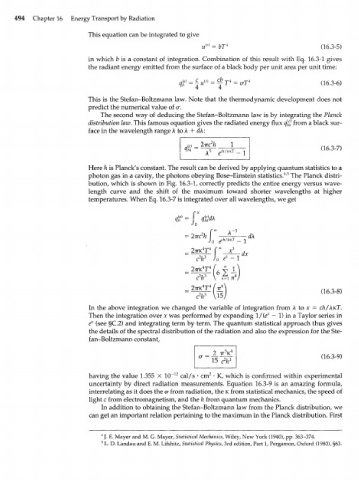Page 514 - Bird R.B. Transport phenomena
P. 514
494 Chapter 16 Energy Transport by Radiation
This equation can be integrated to give
= ьт 4 (16.3-5)
in which b is a constant of integration. Combination of this result with Eq. 16.3-1 gives
the radiant energy emitted from the surface of a black body per unit area per unit time:
qX = - w w = — 1 = а! (16.3-6)
This is the Stefan-Boltzmann law. Note that the thermodynamic development does not
predict the numerical value of cr.
The second way of deducing the Stefan-Boltzmann law is by integrating the Planck
distribution law. This famous equation gives the radiated energy flux $1 from a black sur-
face in the wavelength range Л to Л + dX:
(16.3-7)
Here h is Planck's constant. The result can be derived by applying quantum statistics to a
photon gas in a cavity, the photons obeying Bose-Einstein statistics. ' 4 5 The Planck distri-
bution, which is shown in Fig. 16.3-1, correctly predicts the entire energy versus wave-
length curve and the shift of the maximum toward shorter wavelengths at higher
temperatures. When Eq. 16.3-7 is integrated over all wavelengths, we get
г °°
2
= 2<rrc h
e ch/\KT _
J о 3
4
_ 2тгК Т 4 Г x dx
2 3
c h Jo
l
4
2TTK T 4 '
4
2тгк Т 4 ( TT 4 (16.3-8)
c h
2 3
In the above integration we changed the variable of integration from A to x = ch/ХкТ.
Then the integration over x was performed by expanding l/(e Y - 1) in a Taylor series in
e* (see §C2) and integrating term by term. The quantum statistical approach thus gives
the details of the spectral distribution of the radiation and also the expression for the Ste-
fan-Boltzmann constant,
(16.3-9)
having the value 1.355 X 10 u cal/s ° cm 2 • K, which is confirmed within experimental
uncertainty by direct radiation measurements. Equation 16.3-9 is an amazing formula,
interrelating as it does the o- from radiation, the к from statistical mechanics, the speed of
light с from electromagnetism, and the h from quantum mechanics.
In addition to obtaining the Stefan-Boltzmann law from the Planck distribution, we
can get an important relation pertaining to the maximum in the Planck distribution. First
4
J. E. Mayer and M. G. Mayer, Statistical Mechanics, Wiley, New York (1940), pp. 363-374.
L. D. Landau and E. M. Lifshitz, Statistical Physics, 3rd edition, Part 1, Pergamon, Oxford (1980), §63.
5

